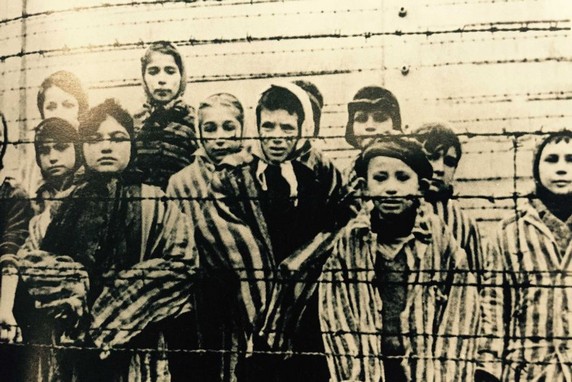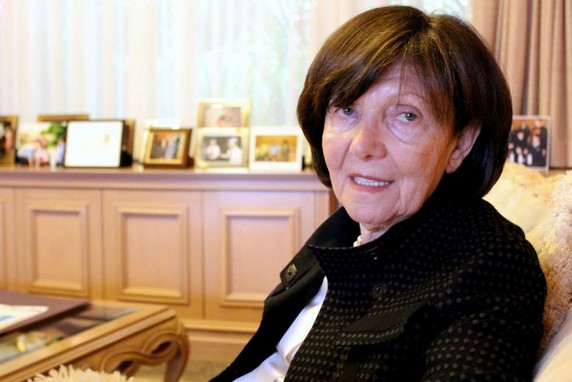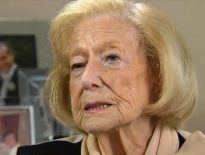A faded photograph of children standing behind barbed wire, taken the day of Auschwitz’s liberation, jogs Eva Slonim’s memory.

It’s a moment the Holocaust survivor remembers with a sort of emptiness – not unlike the blank expressions captured on the children’s faces.
We comprehended that the time in Auschwitz was ending, but we didn’t imagine liberation like that, Ms Slonim said, 70 years on from that day.
Liberation for us meant we could meet our parents, then this didn’t happen. Nobody came to pick us up, we didn’t see anybody we knew.
When the Soviets freed Auschwitz prisoners on January 27, 1945, Eva Slonim was 12 years old.
In the few months she spent there and in detention with SS officers beforehand, she said she lost her childhood.
When your life becomes about survival, you grow up instantly, she said.
Ms Slonim was left with a numbered tattoo marking her place in the Holocaust, and emotional scars that have lasted a lifetime.
Now living in Melbourne, only in recent years has she been able to return to the horror behind those scars and start to share her story with the public.
She spoke at a service for the 70th commemoration of Auschwitz’s liberation in Melbourne’s Holocaust Centre on Tuesday night.
I promised those who, with their last breath when they were dying, said ‘tell the world so this will never happen again’, she said.
Now if these people are so heroic and strong, and on their death bed can leave a legacy the world should know, then I am duty-bound.
It is for this reason she has documented her Holocaust experience, both in her memoir, Gazing at the Stars, and publicly with visitors to the Melbourne Holocaust Centre.
Returning to the horrors
Eva Slonim and her sister Marta were held in a section of Auschwitz reserved for twin siblings.
They were sent there after SS officers were tipped off about their identity, when they were living as Aryans under fake documents.
They tortured us mercilessly because they wanted us to admit we were Jewish, Ms Slonim said.
During her torture, Ms Slonim says she never admitted her identity, because her father warned her of the consequences before they were captured.
He told her don’t ever admit you’re Jewish – once you admit you’ll be condemned to death for sure, but if you don’t admit you’ll have a chance. So fight with every fibre in your body not to admit.
That was in my mind when I was being tortured. In fact, I saw my dad dancing in front of me and that gave me courage, she said.
Her father’s second piece of advice also stayed with Ms Slonim during her greatest trials.
He said ‘look every night at the stars and so will I. Talk to them, complain to them’. So I looked to them in the concentration camp and communicated with my father, Ms Slonim said.
Being held in the ‘twins section’ of Auschwitz meant she and her sister were not immediately condemned to death, but it did have another dark and torturous nature.
Twins’ lives were saved so Nazi physician, Dr Mengele, could use them for experiments, Ms Slonim said.
He maintained twins had a special blood that non-twins didn’t have and if you infused a non-twin with twins’ blood, they would give birth to twins.
Dr Mengele’s non-scientific experiments lead to the death of many twin siblings in Auschwitz.
He drained their blood and sterilised many of the young men and women, or administered experimental medication.
At first I was given injections, which caused me enormous stomach aches. The second time, he took four bottles of my blood and just left, she said.
I felt very weak, hurt and upset that he took so much of my blood.
When asked what gave her strength in Auschwitz, Eva Slonim said she and her sister were stronger together than they would have been alone.
If you had a sister or an aunty or mother, someone close to you – two people were more likely to survive than one, because you support each other, she said.
Recovery and ‘revenge’
On the 70th anniversary of the liberation of Auschwitz, as with every other day, Eva Slonim still fears the Nazi boots that woke her, tortured her, and kept her captive as a 12-year-old.
I have this madness about locking the bedroom door every night, and I have a light under the door so I can see if there are any boots there, she said.
At 4 o’clock I wake up because that’s when I was woken for interrogation, and I still wake up.
I seem normal, during the day, but I’m always reminded of the Holocaust – it’s with me, it’s ingrained.
Ms Slonim was eventually reunited with her parents after the Holocaust, but they never spoke about what any of them endured.

There’s a certain shame about what they (the Nazis) were able to do to me. A certain shame and embarrassment, a regret I had to see all that, she said.
Ms Slonim takes comfort in the knowledge she kept a promise she made to herself after the Holocaust: to have a big family, and to fill her life with love.
That’s my revenge. I wouldn’t touch anybody, I wouldn’t hurt anybody but I would reproduce what was so terribly lost, she said.
Living with her husband in Melbourne and still close to her four children (a fifth died seven years ago) and 27 grandchildren, Eva Slonim is pleased to have made her revenge.





